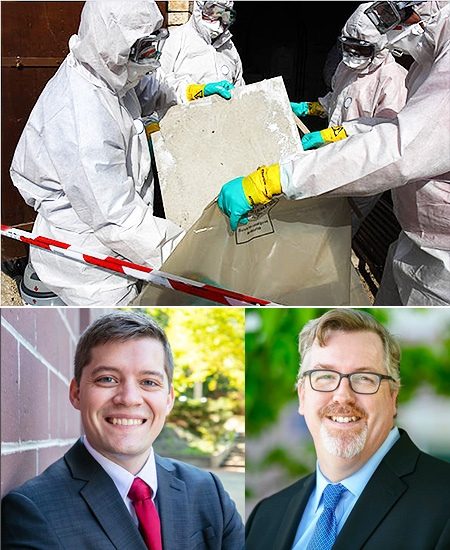Navigating Unexpected Asbestos: Essential Steps for Contractors in Renovation and Demolition
By John Richmond, Sr. Consultant, and Marcus Lehner, Project Manager, Beacon Consulting Group, Inc.
Renovation and demolition projects are complex by nature — with layers of risk, shifting timelines, and evolving site conditions. But few surprises halt momentum quite like the unexpected discovery of asbestos. When this hazardous material shows up mid-project, everything from schedules to budgets — and most importantly, safety — is suddenly at stake.
At Beacon Consulting Group, Inc., we frequently step into projects where a bonded contractor has defaulted, leaving behind incomplete work and unresolved issues. As consultants for surety companies and project stakeholders, we are often responsible for getting troubled projects back on track — safely, efficiently, and in full regulatory compliance. Managing the discovery of asbestos is one of those critical challenges that requires swift, informed, and methodical action.
Whether you’re a contractor, project owner, attorney, or insurance professional, understanding the proper steps to take when asbestos is uncovered is essential for minimizing delays, managing risk, and protecting workers.
10 Essential Steps to Take When Asbestos is Discovered on a Construction Site
1. Stop Work Immediately in the Affected Area - The moment asbestos-containing material (ACM) is suspected or discovered, halt work in the impacted area. This isn’t just best practice — it’s a legal and safety requirement. Continuing work can disturb asbestos fibers and create serious health hazards.
2. Secure and Isolate the Area - Containment is key. The affected zone should be physically secured and clearly marked to prevent unauthorized access. Use signage, caution tape, or barriers to notify all workers and limit exposure. This helps ensure no one unknowingly enters a contaminated zone.
3. Notify the Right Parties Immediately - Inform the project owner, the surety (if applicable), the general contractor, and any relevant subcontractors right away. If you’re working with a construction consultant like Beacon Consulting Group, this is the time to bring us in to help assess the situation and determine the appropriate path forward.
4. Hire a Licensed Asbestos Inspector or Industrial Hygienist - A certified asbestos professional must conduct an inspection to determine:
- Whether asbestos is present,
- Where it’s located,
- Identify the type, quantity and condition,
- What the appropriate remediation strategy should be.
This step is non-negotiable. Understanding what type / form of asbestos is present is especially important. Not all asbestos is the same and the necessary remediation strategy can vary depending on factors such as whether the asbestos is "friable" or "non friable." Friable asbestos is more "fragile" and can be more easily broken down into a powder form (meaning it is potentially more dangerous than non-friable asbestos because its fibers and particles can become "airborne" more easily).
5. Develop (or Revise) an Abatement Plan - If asbestos is confirmed, the project team — with input from environmental consultants and construction experts — must develop a formal abatement plan. This may involve:
- Full removal,
- Encapsulation (sealing),
- Or enclosure of asbestos materials.
The plan should also address worker protection, containment methods, and legal disposal requirements.
6. Coordinate with Environmental Regulators - Each state has its own asbestos handling rules, but federal regulations from OSHA, EPA, and the Clean Air Act (NESHAP standards) must be followed. Ensure all plans are compliant and that required notifications are submitted to the proper agencies before work resumes.
7. Retain a Certified Asbestos Abatement Contractor - Only a licensed asbestos abatement contractor should perform removal or encapsulation. These specialists use proper protective equipment, containment systems, and disposal procedures to ensure the safety of all workers and compliance with environmental laws.
8. Monitor the Abatement Process - A third-party air monitoring professional or industrial hygienist should be engaged to monitor air quality throughout the abatement process. This helps ensure that asbestos fibers do not become airborne — and confirms safe re-entry after cleanup.
9. Obtain Clearance Testing and Documentation - After removal, the affected area must be tested and verified to ensure it is free of airborne asbestos. Final clearance reports should be obtained and shared with the project stakeholders. These reports are essential for protecting against future liability.
10. Resume Construction Activities — Once the area is cleared, construction can resume. Depending on the impact of the abatement, adjustments may be needed to the project schedule, budget, or scope of work. This is where having a construction consultant like Beacon Consulting Group involved makes a significant difference. Our team coordinates with all parties — surety representatives, project owners, abatement professionals, and completion contractors — to ensure the project gets back on track safely and efficiently.
Why This Matters: Protecting People, Timelines, and Liability
Asbestos-related incidents are more than just a nuisance — they are high-risk events with health, legal, and financial implications. Failing to follow proper procedures can:
- Expose workers and the public to carcinogenic fibers,
- Lead to heavy fines from OSHA and EPA,
- Trigger insurance claims or lawsuits,
- Stall the project indefinitely.
Whether you’re a project owner or a surety provider stepping in after a contractor default, it’s critical to act quickly and correctly. A knowledgeable construction consultant like Beacon Consulting Group, Inc. provides the guidance and coordination needed to resolve asbestos-related disruptions with minimal risk and delay.
Partner with Experts Who’ve Been There Before - Unexpected asbestos discovery can feel like a crisis — but with the right process and the right partners, it’s a challenge that can be overcome. At Beacon Consulting Group, we’ve supported countless construction projects through complex issues, including asbestos abatement, contractor failure, and risk mitigation.
Our team brings decades of experience to the table, helping surety companies, developers, and stakeholders complete troubled projects — on solid footing and with confidence.
Questions about managing asbestos or other risks on a construction project?
Contact our team directly to discuss your project needs.
About Marcus Lehner: Click Here For Marcus' Bio
About John Richmond: Click Here For John's Bio
